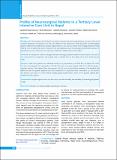Please use this identifier to cite or link to this item:
https://hdl.handle.net/20.500.14356/1573Full metadata record
| DC Field | Value | Language |
|---|---|---|
| dc.contributor.author | Acharya, Subhash Prasad | - |
| dc.contributor.author | Bhattarai, Binita | - |
| dc.contributor.author | Bhattarai, Adheesh | - |
| dc.contributor.author | Pradhan, Saurabh | - |
| dc.contributor.author | Sharma, Mohan Raj | - |
| dc.date.accessioned | 2023-05-16T06:32:10Z | - |
| dc.date.available | 2023-05-16T06:32:10Z | - |
| dc.date.issued | 2018 | - |
| dc.identifier.citation | AcharyaS. P., BhattaraiB., BhattaraiA., PradhanS., & SharmaM. R. (2018). Profile of Neurosurgical Patients in a Tertiary Level Intensive Care Unit in Nepal. Journal of Nepal Health Research Council, 16(3), 336-339. https://doi.org/10.33314/jnhrc.v16i3.1629 | en_US |
| dc.identifier.issn | Print ISSN: 1727-5482; Online ISSN: 1999-6217 | - |
| dc.identifier.uri | http://103.69.126.140:8080/handle/20.500.14356/1573 | - |
| dc.description | Original Article | en_US |
| dc.description.abstract | Abstract Background: Neurosurgery has developed as a separate specialty and neurosurgical patients are some of the most common admitted in the intensive care unit. The objective of the study was to study the profile of neurosurgical patients admitted in level III mixed, medical-surgical intensive care unit in a tertiary level teaching hospital in Nepal with the view to identify the causes of intensive care unit admission, types of neurosurgery performed, outcome of the patients, in terms of intensive care unit stay, mechanical ventilation days and mortality. Methods: A retrospective study was designed and all neurosurgical patients admitted to the intensive care unit of our center between 13 April 2017 and 13April 2018 (1st Baisakh 2074 to 30th Chaitra 2074) were enrolled in this study. Results: A total of 813 patients were admitted in ICU over a period of one year (2074 B.S.) of which 199 (24.48 %) were neurosurgical cases. Among these 170 (85.42%) cases were post-surgical, with 29 (14.58%) being pre-operative patients. One hundred forty nine patients (74.9%) were on mechanical ventilation. One hundred and thirty two (66.3%) patients improved and were transferred to a step down ward. Forty-three (22.5%) died in the intensive care unit, 14 (7.03%) left the hospital against medical advice and 9 (4.5%) patients expired after withdrawal of life support. Conclusions: Despite improved care over the recent years the mortality and morbidity of neurosurgical patients is high. Keywords: Intensive care unit; mortality; neurosurgery; outcome. | en_US |
| dc.language.iso | en | en_US |
| dc.publisher | Nepal Health Research Council | en_US |
| dc.relation.ispartofseries | Jul-Sep 2018;1629 | - |
| dc.subject | Intensive care unit | en_US |
| dc.subject | Mortality | en_US |
| dc.subject | Neurosurgery | en_US |
| dc.subject | Outcome | en_US |
| dc.title | Profile of Neurosurgical Patients in a Tertiary Level Intensive Care Unit in Nepal | en_US |
| dc.type | Journal Article | en_US |
| local.journal.category | Original Article | - |
| Appears in Collections: | Vol. 16 No. 3 Issue 40 Jul - Sep 2018 | |
Files in This Item:
| File | Description | Size | Format | |
|---|---|---|---|---|
| 1629-Manuscript-6674-1-10-20181030.pdf | Fulltext Article. | 200.4 kB | Adobe PDF |  View/Open |
Items in DSpace are protected by copyright, with all rights reserved, unless otherwise indicated.
